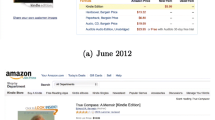Abstract
Despite the interest in measuring price sensitivity of online consumers, most academic work on Internet commerce is hindered by a lack of data on quantity. In this paper we use publicly available data on the sales ranks of about 20,000 books to derive quantity proxies at the two leading online booksellers. Matching this information to prices, we can directly estimate the elasticities of demand facing both merchants as well as create a price index for online books. The results show significant price sensitivity at both merchants but demand at BarnesandNoble.com is much more price-elastic than is demand at Amazon.com. The data also allow us to estimate the magnitude of bias in the CPI due to the rise of Internet sales.
Similar content being viewed by others
References
Amazon.com, e-mail correspondence withcustomer service agent John Armstrong, May 15 2000.
American Booksellers Association, Industry News, “Overall Book Sales Up Slightly for First Six Months of '01”, November 1 2001, <http://www.bookweb.org/home/news/btw/5182.html>, accessed 5/23/02.
Bailey, Joseph P. (1998). “Intermediation and Electronic Markets: Aggregation and Pricing in Internet Commerce”, Ph.D. dissertation, Department of Electrical Engineering and Computer Science, MIT.
BN.com, e-mail correspondence withcustomer service agent Charlie, January 14 2000.
Boskin, Michael J., E. Dulberger, R. Gordon, Z. Griliches, and D. Jorgenson. (1996). “Toward a more accurate measure of the cost of living”, Final Report to the Senate Finance Committee.
Boston Consulting Group, The State of Online Retailing 3.0, with Shop.org November 2000.
Brown, Jeffrey and Austan Goolsbee. (2002). “Does the Internet Make Markets More Competitive? Evidence from the Life Insurance Industry”, Journal of Political Economy 110(3), 481-507.
Brynjolfsson, Erik and Smith, Michael. (2000). “Frictionless Commerce? A Comparison of Internet and Conventional Retailers”, Management Science 46, 563-585.
Cader, Michael. (2001). “Online Bookselling: The New Mythology in the Making”, Publisher's Lunch e-mail newsletter April 16 2001.
Cage, Richard. (1996). “New Methodology for Selecting CPI Outlet Samples”, Monthly Labor Review, December 1996, <http://www.bls.gov/cpi/cpirc001.htm>, accessed 7/3/2002.
Carlton, D. and J. Chevalier. (2001). “Free Riding and Sales Strategies for the Internet”, The Journal of Industrial Economics 49, 441-462.
Chay, Kenneth and James L. Powell. (2001). “Semiparametric censored regression models”, Journal of Economic Perspectives 15, 29-42.
Chevalier, Judith A. and David Scharfstein. (1996). “Capital-Market Imperfections and Countercyclical Markups: Theory and Evidence”, American Economic Review 86, 703-725.
Clay, Karen, Ramayya Krishnan, and Eric Wolff. (2001). “Prices and Price Dispersion on the Web: Evidence from the Online Book Industry”, The Journal of Industrial Economics 49, 521-540.
Ellison, Glenn and Sara Fisher Ellison. (2001). “Search, Obfuscation, and Price Elasticities on the Internet”, MIT working paper.
Goolsbee, Austan. (1999). “Evidence on the High Income Laffer Curve from Six Decades of Tax Reform”, Brookings Papers on Economic Activity 1999(2), 1-47.
Goolsbee, Austan. (2000). “In a World Without Borders: The Impact of Taxes on Internet Commerce”, Quarterly Journal of Economics 115, 561-576.
Goolsbee, Austan. (2001). “Competition in the Computer Industry: Online vs. Retail”, Journal of Industrial Economics 49, 487-499.
Hansell, Saul. (2001). “Listen Up! It's Time for a Profit, A Front-Row Seat as Amazon Gets Serious”, New York Times, May 20 (2001).
Hoch, Stephen J., Kim, Byung-Do, Montgomery, Alan, and Rossi, Peter. (1995). “Determinants of Storelevel Price Elasticity”, Journal of Marketing Research 32, 17-29.
Honore, Bo. (1992). “Trimmed LAD and Least Squares Estimation of Truncated and Censored Regression Models”, Econometrica 60, 533-565.
Italie, Hilltel. (2001). “Amazon's Bottom 10: Not Exactly Page Turners” Chicago Sun-Times, August 17 2001.
Johnson, Norman L. and Samuel Kotz. (1970). Distributions in Statistics: Continuous Univariate Distributions. Vol. 1, Houghton-Mifflin, Boston.
Klemperer, Paul. (1987). “Markets withconsumer switching costs”, Quarterly Journal of Economics 102, 375-394.
Kosala, Raymond and Hendrik Blockeel. (2000). “Web Mining Research: A Survey”, SIGKDD Explorations 2, 1-15.
Kuttner, Robert. (1998). “The Net: A Market Too Perfect for Profits”, Business Week 20, May 11 1998.
Lee, Ho Geun. (1997). “Do Electronic Marketplaces Lower the Price of Goods?” Communications of the ACM 41, 73-80.
Mandelbrot, Benoit B. (1983). Fractal Geometry of Nature. W.H. Freeman and Company.
Pareto, V. (1897). Cours d'Economie Politique. F. Rouge, Lausanne.
Poynter, Daniel. (2002). “Publishing Poynters”, April-June 2000, <http://parapub.com/getpage.cfm?fi-le = newsletter/News0400.html &; userid = 1035600>, accessed June 5 2002.
Quandt, R.E. (1964). “Statistical discrimination among alternative hypotheses and some economic regularities”, Journal of Regional Science 5, 1-23.
Rayport, Jeffrey F., Knoop, Carin-Isabel, and Reavis, Cate. (1998). “Selling Books Online in Mid-1998”, HBS Case 9-899-038.
Reinsdorf, Marshall. (1993). “Price Dispersion, Seller Substitution, and the U.S. CPI”, Bureau of Labor Statistics Working Paper 252.
Schnapp, Madeline and Tim Allwine. (2001). “Mining of book data from Amazon.com”, Presentation at the UCB/SIMS web mining conference, http://www.sims.berkeley.edu/resources/affiliates/workshops/ webmining/slides/ORA.ppt.
Schultze, Charles and Christopher Mackie (ed.) (2002). At What Price? Conceptualizing and Measuring Cost-of-Living and Price Indexes. Committee on National Statistics, National ResearchCouncil, Washington, D.C.: National Academy Press.
Scott Morton, Fiona, Florian Zettlemeyer, and Jorge Silva-Russo. (2001). “Internet Car Retailing”, Journal of Industrial Economics 49, December 2001, 501-519.
Smith, Michael and Erik Brynjolfsson. (2001). “Consumer Decision-making at an Internet Shopbot: Brand Still Matters”, The Journal of Industrial Economics 49, December 2001, 541-558.
Weingarten, Gene. (2001). “Below the Beltway”, Washington Post June 17 2001.
White, E. (2000). “No Comparison. Shopping Bots were Supposed to Unleash Brutal Price Wars. Why Haven't They?” Wall Street Journal, October 23 2000, R18.
Zipf, G.K. (1949). Human Behavior and the Principle of Least Effort: An Introduction to Human Ecology. Addison-Wesley, Cambridge.
Author information
Authors and Affiliations
Rights and permissions
About this article
Cite this article
Chevalier, J., Goolsbee, A. Measuring Prices and Price Competition Online: Amazon.com and BarnesandNoble.com. Quantitative Marketing and Economics 1, 203–222 (2003). https://doi.org/10.1023/A:1024634613982
Issue Date:
DOI: https://doi.org/10.1023/A:1024634613982




